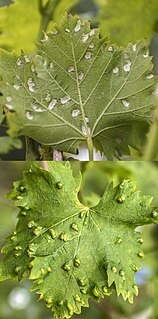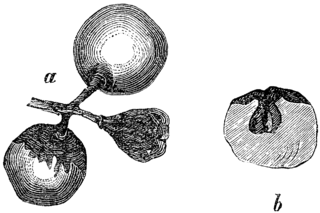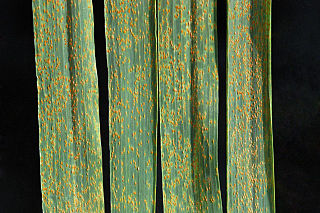 W
WAlternaria leaf spot or Alternaria leaf blight are a group of fungal diseases in plants, that have a variety of hosts. The diseases infects common garden plants, such as cabbage, and are caused by several closely related species of fungi. Some of these fungal species target specific plants, while others have been known to target plant families. One commercially relevant plant genus that can be affected by Alternaria Leaf Spot is Brassica, as the cosmetic issues caused by symptomatic lesions can lead to rejection of crops by distributors and buyers. When certain crops such as cauliflower and broccoli are infected, the heads deteriorate and there is a complete loss of marketability. Secondary soft-rotting organisms can infect stored cabbage that has been affected by Alternaria Leaf Spot by entering through symptomatic lesions. Alternaria Leaf Spot diseases that affect Brassica species are caused by the pathogens Alternaria brassicae and Alternaria brassicicola.
 W
WBacterial leaf scorch is a disease state affecting many crops, caused mainly by the xylem-plugging bacterium Xylella fastidiosa. It can be mistaken for ordinary leaf scorch caused by cultural practices such as over-fertilization.
 W
WBlack spot leaf disease is a physiological plant disorder that affects some grape varieties such as Concord. It is essentially a potassium deficiency that causes the leaves on a vine to turn purple and eventually black as chlorophyll is lost. For wine growers this lack of chlorophyll inhibits the vine's ability to transmit sugar to the grape, leaving the resulting grapes with a low brix count that may be less than ideal for wine making.
 W
WCherry leaf spot is a fungal disease which infects cherries and plums. Sweet, sour, and ornamental cherries are susceptible to the disease, being most prevalent in sour cherries. The variety of sour cherries that is the most susceptible are the English morello cherries. This is considered a serious disease in the Midwest, New England states, and Canada. It has also been estimated to infect 80 percent of orchards in the Eastern states. It must be controlled yearly to avoid a significant loss of the crop. If not controlled properly, the disease can dramatically reduce yields by nearly 100 percent. The disease is also known as yellow leaf or shothole disease to cherry growers due to the characteristic yellowing leaves and shot holes present in the leaves upon severe infection.
 W
WCommon spot of strawberry is one of the most common and widespread diseases of strawberry. Common spot of strawberry is caused by the fungus Mycosphaerella fragariae. Symptoms of this disease first appear as circular, dark purple spots on the leaf surface. Mycosphaerella fragariae is very host-specific and only infects strawberry.
 W
WGrey leaf spot (GLS) is a foliar fungal disease that affects maize, also known as corn. GLS is considered one of the most significant yield-limiting diseases of corn worldwide. There are two fungal pathogens that cause GLS: Cercospora zeae-maydis and Cercospora zeina. Symptoms seen on corn include leaf lesions, discoloration (chlorosis), and foliar blight. Distinct symptoms of GLS are rectangular, brown to gray necrotic lesions that run parallel to the leaf, spanning the spaces between the secondary leaf veins. The fungus survives in the debris of topsoil and infects healthy crop via asexual spores called conidia. Environmental conditions that best suit infection and growth include moist, humid, and warm climates. Poor airflow, low sunlight, overcrowding, improper soil nutrient and irrigation management, and poor soil drainage can all contribute to the propagation of the disease. Management techniques include crop resistance, crop rotation, residue management, use of fungicides, and weed control. The purpose of disease management is to prevent the amount of secondary disease cycles as well as to protect leaf area from damage prior to grain formation. Corn grey leaf spot is an important disease of corn production in the United States, economically significant throughout the Midwest and Mid-Atlantic regions. However, it is also prevalent in Africa, Central America, China, Europe, India, Mexico, the Philippines, northern South America, and Southeast Asia. The teleomorph of Cercospora zeae-maydis is assumed to be Mycosphaerella sp.
 W
WDidymascella thujina is an ascomycete fungus in the family Helotiaceae. D. thujina causes cedar leaf blight, a leaf disease, on western red cedar and white cedar (T. occidentalis).
 W
WDidymella rabiei, commonly called chickpea ascochyta blight fungus is a fungal plant pathogen of chickpea. Didymella rabiei is the teleomorph of Ascochyta rabiei, which is the anamorph, but both names are the same species.
 W
WEriophyes vitis is a mite species in the genus Eriophyes infecting grape leaves.
 W
WPeach leaf curl is a plant disease characterized by distortion and coloration of leaves and is caused by the fungus Taphrina deformans, which infects peach, nectarine, and almond trees. T. deformans is found in the United States, Europe, Asia, Africa, Australia, and New Zealand. Peach leaf curl reduces the amount of leaves and fruit produced by peach and nectarine trees.
 W
WA Leaf Spot is a limited, discoloured, diseased area of a leaf that is caused by fungal, bacterial or viral plant diseases, or by injuries from nematodes, insects, environmental factors, toxicity or herbicides. These discoloured spots or lesions often have a centre of necrosis or cell death. Symptoms can overlap across causal agents, however differing signs and symptoms of certain pathogens can lead to the diagnosis of the type of leaf spot disease. Prolonged wet and humid conditions promote leaf spot disease and most pathogens are spread by wind, splashing rain or irrigation that carry the disease to other leaves.
 W
WPhaeoramularia dissiliens is a fungal plant pathogen which causes cercospora leaf spot on grapes.
 W
WPhomopsis obscurans is a common fungus found in strawberry plants, which causes the disease of leaf blight. Common symptoms caused by the pathogen begin as small circular reddish-purple spots and enlarge to form V-shaped lesions that follow the vasculature of the plant’s leaves. Although the fungus infects leaves early in the growing season when the plants are beginning to develop, leaf blight symptoms are most apparent on older plants towards the end of the growing season. The disease can weaken strawberry plants through the destruction of foliage, which results in reduced yields. In years highly favorable for disease development, leaf blight can ultimately lead to the death of the strawberry plants. A favorable environment for the growth and development of the Phomopsis obscurans pathogen is that of high temperature, high inoculum density, a long period of exposure to moisture, and immature host tissue. In the case of disease management, a conjunction of cultural practices is the most effective way of reducing the infection.
 W
WPuccinia hordei is a species of rust fungus. A plant pathogen, it can cause barley brown rust.
 W
WPuccinia malvacearum, also known as hollyhock or mallow rust, is a species within the genus Puccinia known for attacking members of the family Malvaceae. An autoecious pathogen, it can complete its life cycle using a single host.
 W
WSouthern corn leaf blight (SCLB) is a fungal disease of maize caused by the plant pathogen Bipolaris maydis.
 W
WWheat leaf rust is a fungal disease that affects wheat, barley and rye stems, leaves and grains. In temperate zones it is destructive on winter wheat because the pathogen overwinters. Infections can lead up to 20% yield loss, which is exacerbated by dying leaves, which fertilize the fungus. The pathogen is Puccinia rust fungus. Puccinia graminis causes "stem or black rust", P. triticina causes "leaf or brown rust", and P. striiformis causes "strip or yellow rust". It is the most prevalent of all the wheat rust diseases, occurring in most wheat growing regions. It causes serious epidemics in North America, Mexico and South America and is a devastating seasonal disease in India. All three types of Puccinia are heteroecious requiring two distinct and distantly related hosts. Rust and the similar smut are members of the class Pucciniomycetes but rust is not normally a black powdery mass.